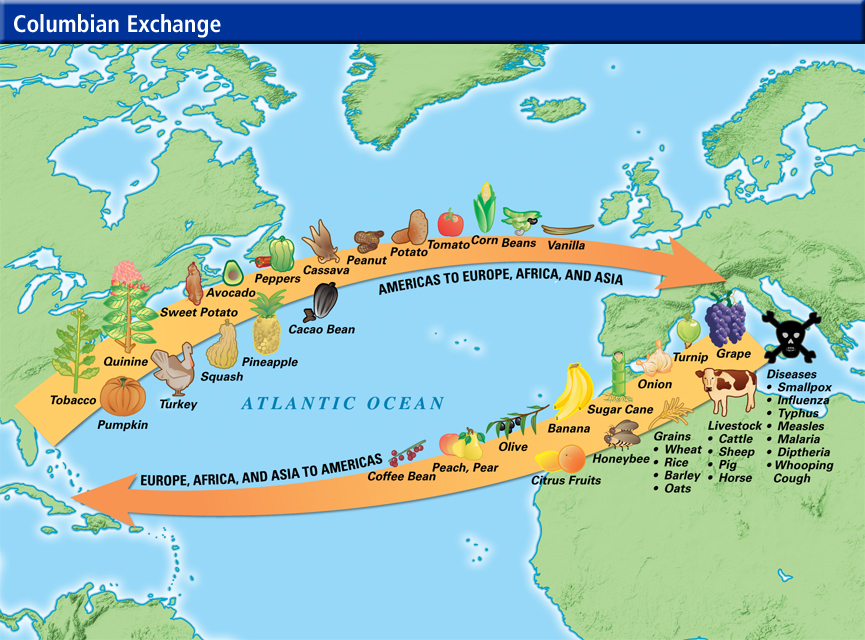Exploring The Columbus Exchange: A Gateway To Global Trade
The Columbus Exchange has become synonymous with the vibrant exchange of goods, culture, and ideas that transformed the world in the late 15th and early 16th centuries. This pivotal moment in history marked the beginning of globalization, as explorers like Christopher Columbus embarked on daring voyages across uncharted waters, ultimately leading to the discovery of the Americas. As we delve into the significance of the Columbus Exchange, it is crucial to understand its far-reaching implications that shaped not only trade but also the very fabric of societies across continents.
In the wake of Columbus's expeditions, the exchange of various commodities, including spices, precious metals, and agricultural products, surged to unprecedented levels. The Columbian Exchange, as it is often referred to, facilitated the transfer of not only tangible goods but also ideas, technologies, and even populations. This cross-pollination of cultures laid the groundwork for the modern world, fostering connections between Europe, Africa, and the Americas that would have lasting effects on history and economies.
As we investigate the Columbus Exchange further, we will uncover the complexities surrounding this period, addressing questions regarding its impact on indigenous populations, the environment, and the emergence of new social structures. The consequences of this exchange are still felt today, prompting a deeper examination of how a single event can alter the course of history and shape the world we live in.
What Were the Key Components of the Columbus Exchange?
The Columbus Exchange entailed a multitude of elements that contributed to the dramatic transformation of global trade dynamics. Key components include:
- Commodities: The movement of goods such as tobacco, sugar, and cotton.
- Cultural Exchanges: The sharing of languages, religions, and customs between different civilizations.
- Biological Exchanges: The introduction of new species of plants and animals to various continents.
- Population Movements: The forced migration of enslaved people and the movement of settlers.
How Did the Columbus Exchange Affect Indigenous Populations?
The impact of the Columbus Exchange on indigenous populations was profound and often devastating. The introduction of European diseases, such as smallpox, decimated native communities that had no immunity. Additionally, the demand for labor led to the enslavement of many indigenous peoples, disrupting their traditional ways of life and causing widespread suffering.
What Role Did Agriculture Play in the Columbus Exchange?
Agriculture was a cornerstone of the Columbus Exchange, as new crops were introduced to different regions, transforming diets and economies. The exchange of staple crops like maize, potatoes, and tomatoes from the Americas to Europe revolutionized food production and consumption patterns. Conversely, European crops such as wheat and sugarcane were introduced to the New World, significantly impacting agricultural practices and land use.
What Were the Economic Implications of the Columbus Exchange?
The economic repercussions of the Columbus Exchange were far-reaching. The influx of precious metals from the Americas into Europe spurred economic growth and contributed to the rise of capitalism. Trade networks expanded, leading to the establishment of new markets and the growth of cities. This economic transformation laid the groundwork for the modern global economy.
How Did the Columbus Exchange Influence Cultural Identity?
The Columbus Exchange facilitated a blending of cultures, giving rise to new identities and social structures. The interaction between diverse populations led to the emergence of unique cultural expressions, from cuisine to music and art. This cultural fusion continues to shape societies around the world, highlighting the importance of understanding our shared history.
What Challenges Arise from the Columbus Exchange?
While the Columbus Exchange brought about significant advancements, it also raised ethical concerns and challenges. The exploitation of indigenous peoples, the environmental impact of new agricultural practices, and the legacy of colonialism are critical issues that demand attention. Acknowledging these challenges is essential for fostering a more equitable and sustainable future.
Conclusion: Reflecting on the Legacy of the Columbus Exchange
The Columbus Exchange serves as a testament to the complexity of human interactions and the profound effects of globalization. As we reflect on this pivotal moment in history, it is essential to recognize both the positive advancements and the challenges that arose from this exchange. Understanding the nuances of the Columbus Exchange allows us to appreciate the interconnectedness of our world today and encourages dialogue about our collective past.
| Aspect | Details |
|---|---|
| Name | Columbus Exchange |
| Period | Late 15th to early 16th centuries |
| Key Figure | Christopher Columbus |
| Significant Developments | Global trade expansion, cultural exchange, biological transfer |
| Major Impacts | Demographic shifts, economic growth, cultural fusion |
Unraveling The Complex Legacy Of Adolf Hitler
Discovering The Unique World Of G Eazy
Exploring The Lives Of Today’s Influencers: Current Biographies


